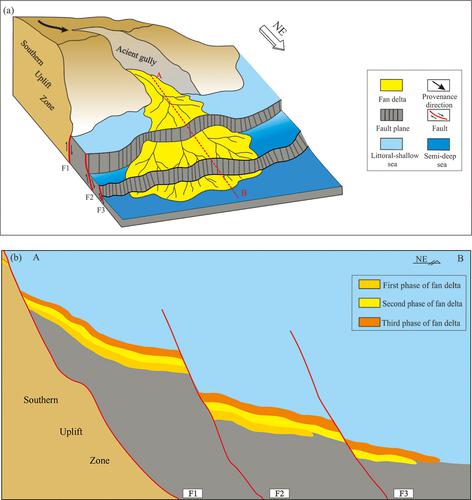当前位置:
X-MOL 学术
›
Acta Geol. Sinica Engl. Ed.
›
论文详情
Our official English website, www.x-mol.net, welcomes your feedback! (Note: you will need to create a separate account there.)
Source‐sink System and Sedimentary Model of Progradational Fan Delta Controlled by Restricted Ancient Gully: An Example in the Enping Formation in the Southern Baiyun Sag, Pearl River Mouth Basin, Northern South China Sea
Acta Geologica Sinica-English Edition ( IF 3.3 ) Pub Date : 2021-01-08 , DOI: 10.1111/1755-6724.14627 Congjun FENG 1, 2 , Xingzong YAO 1, 2 , Haizhang YANG 3 , Daming Li 1, 2 , Mengsi SUN 4
Acta Geologica Sinica-English Edition ( IF 3.3 ) Pub Date : 2021-01-08 , DOI: 10.1111/1755-6724.14627 Congjun FENG 1, 2 , Xingzong YAO 1, 2 , Haizhang YANG 3 , Daming Li 1, 2 , Mengsi SUN 4
Affiliation

|
Tectonic activity occurred during the depositional period of the Enping Formation in the southern Baiyun Sag in the Pearl River Mouth Basin, with a series of synsedimentary faults and a set of large fan delta reservoir bodies developing. There is no data from drilling, cores, etc. for this area, so this paper applies three‐dimensional seismic data to study the structural style of the steep slope zone, the seismic facies characteristics of fan deltas, and the source‐sink system and sedimentary model of the Enping Formation. The control action of tectonic activity on fan deltaic sedimentary systems is studied by combining interpretation of fault systems, dissection of structural styles, seismic reflection structure, seismic facies geometry, and seismic attribute analysis, together with theoretical analysis of the source‐sink deposition process. The Baiyun Sag has experienced tectonic activity since the Eocene, and a series of synsedimentary faults are developed in the southern steep slope zone. Under the common control of multiple large synsedimentary faults, a large ancient gully formed in the steep slope zone in the south, which gradually widened from south to north. The uplift area in the southern part of the sag was exposed for a long time during the deposition of the Enping Formation and consequently suffered weathering and erosion. The resulting sediments were transported through a system of provenance channels composed of slopes and an ancient gully to the depression area, where they were deposited and eventually converged to form a large fan delta. The fan delta presents the overall characteristics of NS strong wedge reflection and EW strong domal reflection—thick in the middle part and thin in the wings. It displays a lobe‐shaped distribution on the plane, with the fan root pointing to the south slope. According to differences in reflection intensity from bottom to top, it can be subdivided into three stages of progradational sedimentary bodies—the southern uplift and denudation zone, the large ancient gully, and the fan delta—which together constitute a complete source‐sink system. This represents a sedimentary model of progradational fan delta under the overall joint control of the restricted ancient gully and syndepositional faults.
中文翻译:

有限古沟控制的扇状三角洲源汇系统和沉积模式-以南海北部珠江口盆地白云凹陷南部恩平组为例
构造活动发生在珠江口盆地白云凹陷南部恩平组沉积期,伴有一系列同沉积断层和一组大型扇三角洲储层。该地区没有来自钻探,岩心等的数据,因此本文采用三维地震数据研究陡坡带的构造样式,扇三角洲的地震相特征以及源汇系统和恩平组沉积模型。通过结合断层系统的解释,构造样式的剖析,地震反射结构,地震相几何学和地震属性分析,以及源-汇沉积过程的理论分析,研究了构造活动对扇三角洲沉积系统的控制作用。自始新世以来,白云凹陷经历了构造活动,南部陡坡带发育了一系列同沉积断裂。在多个大型同沉积断裂的共同控制下,南部陡峭的斜坡带形成了一个大型的古沟,从南向北逐渐扩大。在恩平组沉积过程中,凹陷南部的隆升区暴露了很长时间,因此遭受了风化和侵蚀。产生的沉积物通过由坡度和古沟组成的物源通道系统运输到to陷区,在那里沉积并最终汇聚成一个大扇形三角洲。扇形三角洲展示了NS强楔形反射和EW强穹顶反射的总体特征-中部较厚,机翼较薄。它在平面上显示出叶状分布,扇根指向南坡。根据从底部到顶部的反射强度差异,可以将其划分为三个阶段的沉积沉积体—南部隆起剥蚀带,大型古代沟壑和扇形三角洲,它们共同构成了一个完整的源汇系统。这代表了在受限制的古代沟壑和同沉积断层的整体联合控制下的沉积扇三角洲沉积模型。根据从底部到顶部的反射强度差异,可以将其划分为三个阶段的沉积沉积体—南部隆起剥蚀带,大型古沟和扇三角洲,它们共同构成了一个完整的源汇系统。这代表了在受限制的古沟和同沉积断层的整体联合控制下的沉积扇三角洲的沉积模型。根据从底部到顶部的反射强度差异,可以将其划分为三个阶段的沉积沉积体—南部隆起剥蚀带,大型古沟和扇三角洲,它们共同构成了一个完整的源汇系统。这代表了在受限制的古沟和同沉积断层的整体联合控制下的沉积扇三角洲的沉积模型。
更新日期:2021-02-22
中文翻译:

有限古沟控制的扇状三角洲源汇系统和沉积模式-以南海北部珠江口盆地白云凹陷南部恩平组为例
构造活动发生在珠江口盆地白云凹陷南部恩平组沉积期,伴有一系列同沉积断层和一组大型扇三角洲储层。该地区没有来自钻探,岩心等的数据,因此本文采用三维地震数据研究陡坡带的构造样式,扇三角洲的地震相特征以及源汇系统和恩平组沉积模型。通过结合断层系统的解释,构造样式的剖析,地震反射结构,地震相几何学和地震属性分析,以及源-汇沉积过程的理论分析,研究了构造活动对扇三角洲沉积系统的控制作用。自始新世以来,白云凹陷经历了构造活动,南部陡坡带发育了一系列同沉积断裂。在多个大型同沉积断裂的共同控制下,南部陡峭的斜坡带形成了一个大型的古沟,从南向北逐渐扩大。在恩平组沉积过程中,凹陷南部的隆升区暴露了很长时间,因此遭受了风化和侵蚀。产生的沉积物通过由坡度和古沟组成的物源通道系统运输到to陷区,在那里沉积并最终汇聚成一个大扇形三角洲。扇形三角洲展示了NS强楔形反射和EW强穹顶反射的总体特征-中部较厚,机翼较薄。它在平面上显示出叶状分布,扇根指向南坡。根据从底部到顶部的反射强度差异,可以将其划分为三个阶段的沉积沉积体—南部隆起剥蚀带,大型古代沟壑和扇形三角洲,它们共同构成了一个完整的源汇系统。这代表了在受限制的古代沟壑和同沉积断层的整体联合控制下的沉积扇三角洲沉积模型。根据从底部到顶部的反射强度差异,可以将其划分为三个阶段的沉积沉积体—南部隆起剥蚀带,大型古沟和扇三角洲,它们共同构成了一个完整的源汇系统。这代表了在受限制的古沟和同沉积断层的整体联合控制下的沉积扇三角洲的沉积模型。根据从底部到顶部的反射强度差异,可以将其划分为三个阶段的沉积沉积体—南部隆起剥蚀带,大型古沟和扇三角洲,它们共同构成了一个完整的源汇系统。这代表了在受限制的古沟和同沉积断层的整体联合控制下的沉积扇三角洲的沉积模型。



























 京公网安备 11010802027423号
京公网安备 11010802027423号